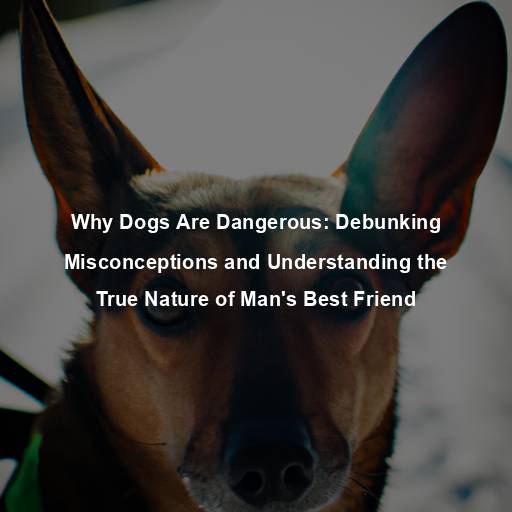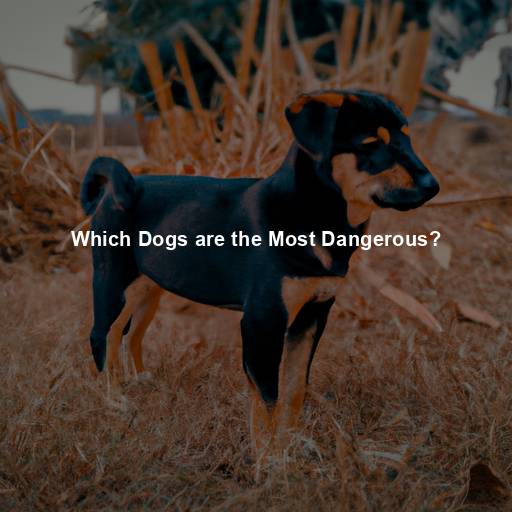Why Dogs Are Dangerous: Debunking Misconceptions and Understanding the True Nature of Man’s Best Friend
Last Updated on August 8, 2023 by Evan
Contents
- 1 The Fascinating Bond Between Humans and Dogs
- 1.1 The Nature vs. Nurture Debate: Genetics and Upbringing
- 1.2 The Impact of Socialization and Training
- 1.3 Identifying Aggressive Behavior: Fear vs. Aggression
- 1.4 Recognizing Warning Signs: Body Language and Communication
- 1.5 The Role of Responsible Ownership
- 1.6 Breed-Specific Legislation: Addressing Controversies
- 1.7 Educating the Community: Prevention and Awareness
- 1.8 Collaboration and Research: Advancing Our Understanding
- 2 Embracing the Complexity of the Human-Dog Relationship
- 3 Understanding Canine Body Language: Key to Prevention
- 4 Promoting Responsible Ownership: Ensuring Safety
- 5 Breed-Specific Legislation: A Controversial Approach
- 6 Continued Research: Advancing our Knowledge
- 7 Embracing the Complexity: Achieving Balance
- 8 FAQs – Why Dogs are Dangerous
The Fascinating Bond Between Humans and Dogs
Throughout the ages, dogs have stood as steadfast pillars of companionship, affection, and guardianship. Yet, as we delve into the intricacies of the potential dangers they can pose, it becomes crucial to embrace a perspective grounded in curiosity and empathy, honoring the profound connection that exists between humans and their loyal canines. Granting due acknowledgement to instances of aggression, it is imperative that we dismantle misguided beliefs and delve into the complex web of influences that give rise to such behaviors.
The Nature vs. Nurture Debate: Genetics and Upbringing
When examining the potential dangers associated with dogs, it is crucial to consider the interplay between genetics and upbringing. Like humans, dogs are influenced by both nature and nurture. While certain breeds may have a predisposition towards certain traits, such as strength or protective instincts, it is important to remember that individual experiences and training play a significant role in shaping a dog’s behavior.
The Impact of Socialization and Training
Understanding dog behavior is a fascinating journey that dives deep into the bewildering world of socialization and training. The impact of these factors on our four-legged friends is a captivating puzzle that we can’t help but unravel. It’s no secret that dogs who have been skillfully socialized since puppyhood, immersed in different settings, and trained through positive reinforcement techniques tend to showcase a harmonious and non-intimidating demeanor. Conversely, those who were deprived of sufficient socialization or subjected to cruel training methods may unleash their aggression in unpredictable ways, leaving us perplexed yet even more determined to comprehend their complex nature.
Identifying Aggressive Behavior: Fear vs. Aggression
When it comes to the complexities of dog behavior, it’s imperative to unravel the tangled web between fear and aggression. Dogs, being sentient creatures, have their own emotional landscapes, and sometimes fear can ignite aggressive responses. Peering into the depths of a dog’s psyche is pivotal in effectively navigating potential dangers and ensuring optimal safety measures are in place.
Recognizing Warning Signs: Body Language and Communication
Dogs have their own unique ways of communicating their emotions, and it is our responsibility as pet owners and enthusiasts to recognize and respect these signals. By familiarizing ourselves with a dog’s body language, such as raised hackles, tense posture, or growling, we can better understand when a dog may be feeling threatened or uncomfortable. This knowledge allows us to take appropriate measures to diffuse potentially dangerous situations.
The Role of Responsible Ownership
In a world where the debate around dogs seems to be gaining momentum, it is crucial to strike a balance between raising awareness about potential risks and highlighting the positive impact of responsible ownership. The cornerstone of responsible dog ownership lies in the dedication to the socialization, training, and overall welfare of our furry companions. It is imperative for dog owners to create a secure and nurturing haven for their pets, closely monitoring their activities and taking all the necessary precautions when their paths intertwine with others. By embracing responsible ownership, we can navigate the intricate tapestry of dog-human interactions with grace and harmony.
Breed-Specific Legislation: Addressing Controversies
Breed-specific legislation has been a topic of controversy in many jurisdictions, with certain breeds being labeled as inherently dangerous. However, it is crucial to recognize that breed alone does not determine a dog’s behavior. Generalizations based on breed can perpetuate misconceptions and unfairly stigmatize certain dogs. Instead, focusing on individual dog assessments, behavior evaluations, and responsible ownership practices can lead to more effective and fair approaches to public safety.
Educating the Community: Prevention and Awareness
In the ever-evolving realm of pet care, a harmonious coexistence between humans and dogs remains a beguiling challenge. Illuminating the enigmatic corridors of responsible pet ownership, fostering a profound understanding of the intricacies of socializing our four-legged friends, and sharpening our acumen in the cryptic art of discerning warning signs, can spiral us downwards towards the abyss of fewer dog-related incidents. Chiseling away the rough edges of ignorance, if we strive to cultivate a society entrenched in empathy, laced with compassion, and adorned with reverence for our fuzzy companions, we will forge an indomitable fortress of security for all souls that traverse this earthly realm.
Collaboration and Research: Advancing Our Understanding
Exploring the intricate realm of dog behavior and its intricate connection to aggression demands an intricate web of collaboration between the bright minds of animal behaviorists, skilled veterinarians, and savvy trainers. With an insatiable thirst for knowledge, ongoing research and the fruitful exchange of wisdom pave the way towards unraveling the perplexing complexities of why dogs harbor dangerous tendencies, enabling the development of innovative prevention tactics and effective intervention strategies. Together, as a united force, we can strive towards a future where canine understanding reigns supreme.
Embracing the Complexity of the Human-Dog Relationship
In conclusion, it is crucial to approach the topic of why dogs are dangerous with a balanced and informed perspective. While it is true that dogs, like any living beings, have the potential to exhibit aggressive behaviors, it is equally important to recognize the countless positive qualities they bring into our lives. By understanding the factors that contribute to dog aggression, promoting responsible ownership, and fostering a culture of education and awareness, we can navigate the complexities of the human-dog relationship and ensure a safer and more harmonious coexistence. ## The Influence of Environment: Nature and Nurture Revisited
Environmental Factors: Impact on Dog Behavior
When it comes to a dog’s behavior, it’s not just about genetics. Their environment and life experiences also have a major say in how they turn out. A pooch who grows up with plenty of positive social interaction, a range of different environments, and some good ol’ training from day one is much more likely to be a well-rounded and non-threatening companion. It’s all about giving them the best start in life, because, just like humans, dogs are shaped by what they experience.
The Power of Positive Reinforcement
Training methods based on positive reinforcement have proven to be highly effective in shaping desirable behaviors and reducing the likelihood of aggression in dogs. By rewarding desired behaviors with treats, praise, or play, we can create a strong bond with our furry friends while encouraging them to exhibit appropriate behaviors.
The Dangers of Neglect and Abuse
In today’s complex world, we must confront the harsh truth that neglect and abuse can have dire consequences for our beloved furry friends. Dogs, those loyal companions who bring so much joy to our lives, can sadly bear the brunt of mistreatment and isolation. The heartbreaking result? Fear-driven aggression, a desperate attempt to shield their vulnerable souls from further harm.
Understanding Canine Body Language: Key to Prevention
Interpreting Nonverbal Cues
Understanding the nonverbal language of dogs is key to communicating effectively with our furry companions. It’s fascinating how these intelligent creatures express themselves through facial expressions, body postures, tail wagging, and ear movements. By tuning into these subtle cues, we can gain deeper insights into their emotions and even anticipate signs of aggression, allowing us to foster a better understanding and connection with our beloved canine friends.
Tail Position: A Window to Emotions
A dog’s tail position can reveal valuable insights into their emotional state. A relaxed and wagging tail typically indicates a friendly and approachable demeanor. Conversely, a tucked tail or a stiff, rigid wag may suggest fear, anxiety, or potential aggression. It is important to approach dogs with caution and respect, especially if their tail position indicates discomfort.
Facial Expressions: Eyes and Ears
Dogs, those enigmatic and marvelous creatures, possess a world of communication hidden within their eyes and ears. Soft, relaxed eyes gazing upon the world, coupled with ears positioned naturally, speak volumes of their inner tranquility and fulfillment. Yet, when those eyes narrow, fixate, or the ears raise, a profound message of potential aggression or discomfort is undeniably conveyed. It is within our power to decipher these subtle signals, unlocking the cryptic realm of a dog’s emotional landscape, and thus adapt our own conduct with the utmost sensitivity.
The Power of Posture
Have you ever wondered what your furry friend is trying to communicate through their body language? Well, let me tell you, a dog’s posture can be an intriguing puzzle to solve! When you see your dog standing tall with a relaxed demeanor, it’s like witnessing a burst of confidence and warmth. But beware of that lowered body stance or those raised hackles – they might just be unveiling a perplexing mix of fear, agitation, or even a hint of aggression.
Promoting Responsible Ownership: Ensuring Safety
Early Socialization: Building a Foundation
Early socialization is crucial to the development of a well-rounded and socially adept dog. Introducing puppies to a variety of people, animals, environments, and experiences from a young age helps them become more adaptable and less prone to fear-based aggression. Responsible owners prioritize early socialization to create a solid foundation for their dog’s future behavior.
Training: Building Trust and Communication
When it comes to being a responsible dog owner, training is an absolute must. It’s more than just teaching your canine companion some fancy commands; it’s about building an unbreakable bond between you and your furry friend. By adopting positive reinforcement techniques, you not only set clear expectations for your four-legged pal but also create a safe and nurturing environment that significantly reduces the chances of any aggressive tendencies creeping in. Trust me, investing time and effort in consistent, reward-based training is the key to a harmonious relationship with your dog.
Exercise and Mental Stimulation: Channeling Energy
In the fascinating world of dog care, two essential ingredients seem to hold the key to a harmonious furry existence: regular exercise and mental stimulation. These seemingly mundane components have a profound impact on the overall well-being and behavior of our canine companions. It has been observed that dogs bestowed with the right amount of physical exertion and cognitive challenges display remarkable resilience against destructive or aggressive tendencies fueled by the treacherous duo of frustration and boredom. Wise and devoted pet parents rise to the occasion by diligently offering their furry friends various energy outlets: from invigorating daily strolls to captivating interactive toys and captivating activities that keep those wagging tails and inquisitive minds perpetually entertained.
Responsible Supervision: Ensuring Safety for All
Responsible dog owners understand the importance of appropriate supervision, especially when interacting with unfamiliar individuals or animals. By closely monitoring their dog’s behavior and intervening when necessary, owners can prevent potential conflicts and ensure the safety of both their dog and others.
Breed-Specific Legislation: A Controversial Approach
The Limitations of Breed Stereotyping
When it comes to breed-specific legislation (BSL), opinions are certainly varied and heated. Proponents believe that these laws are essential for public safety, but it’s important to acknowledge the complexities of labeling breeds as “dangerous”. Simply painting an entire breed with a broad brush based on the actions of a few can lead to harmful misconceptions, unfairly attaching stigma to certain dogs. It’s clear that addressing the root causes of aggression is where our focus should truly lie.
Focusing on Individual Assessments
Instead of relying on breed-specific legislation, a more effective approach involves individual dog assessments. Evaluating a dog’s behavior, temperament, and history on a case-by-case basis allows for a more accurate understanding of their potential risks and appropriate measures to address any concerns. This approach emphasizes responsible ownership and accountability, treating each dog as an individual rather than a representative of their breed.
Continued Research: Advancing our Knowledge
The Evolving Field of Canine Behavior
The study of canine behavior is a dynamic field that continues to evolve. Researchers, behaviorists, and veterinarians are constantly expanding our understanding of dog behavior, aggression, and the factors that contribute to it. Ongoing research serves as the foundation for developing evidence-based strategies and interventions to prevent and manage aggression in dogs.
Collaboration for a Safer Future
Advancing our knowledge of canine behavior and addressing the potential dangers associated with dogs requires collaboration between various stakeholders. Animal behaviorists, veterinarians, dog trainers, and responsible dog owners can join forces to share insights, exchange ideas, and implement effective practices. By working together, we can continue to refine our understanding and develop innovative approaches to ensure the safety of both humans and dogs.
Embracing the Complexity: Achieving Balance
In conclusion, the topic of why dogs are dangerous warrants a nuanced and balanced perspective. While it is essential to acknowledge the potential risks associated with certain dog behaviors, it is equally important to recognize the countless positive attributes that dogs bring into our lives. By understanding the complex interplay between genetics, environment, training, and responsible ownership, we can promote a harmonious and safe coexistence between humans and their canine companions. Let us embrace the beauty of this unique bond and work towards a future where both humans and dogs can thrive together.
FAQs – Why Dogs are Dangerous
What are some reasons why dogs can be dangerous?
Dogs, those enigmatic creatures of boundless potential, encompass a perplexing duality that forces us to grapple with the question of their inherent danger. With nary a regard for breed or size, their potential to nip or unleash fury upon provocation or perceived threat is a constant reminder of their untamed nature. These canines, driven by an innate primal instinct to safeguard their domain, are capable of exhibiting behaviors that can only be described as aggressive, making us question the precarious balance between their loyalty and their latent savagery. Alas, we find ourselves confronted with the truth that untrained or poorly-socialized dogs have the capacity to bewilder us with their unpredictability, leaving us and our fellow creatures at risk in the face of their mysterious allure.
Are certain dog breeds more dangerous than others?
When it comes to our four-legged friends, it’s crucial to acknowledge that each dog has its own unique personality. However, certain breeds have gained notoriety for their potentially more assertive or protective nature. It’s important to stress, though, that no breed can be labeled as inherently dangerous. A dog’s upbringing, training, and individual temperament are key factors that influence its behavior, regardless of its breed.
How can I recognize signs of aggression in dogs?
Recognizing signs of aggression in dogs is crucial for preventing potential dangers. Common signs of aggression include growling, baring teeth, raised fur on the back, a stiff or rigid body posture, direct eye contact, or a low-pitched bark or snarl. It is important to note that these signs may be accompanied by other warning behaviors, such as a tucked tail or avoidance. If you observe any of these signs, it is essential to exercise caution and give the dog its space to avoid escalating the situation.
How can I ensure my safety around dogs?
Ensuring your safety in the presence of our four-legged friends requires a fervent devotion to following precautionary measures. Approach these furry companions with cautious steps and the gracious permission of their human counterparts. Avert abrupt or menacing movements that could potentially ignite a spark of defensiveness in their hearts. Educate the younger generation on the sacred art of respectful interaction, under the ever-watchful eyes of vigilant adults. Tread lightly, refraining from locking eyes or extending hands towards unfamiliar canines, as it might ignite a sense of unease in even the most amiable of canines. In the unfortunate event of encountering an aggressive canine, summon your inner tranquility, divert your gaze elsewhere, and commence a gentle retreat without resorting to hasty dashes or untamed hollers.
What steps can be taken to prevent dog attacks?
Preventing dog attacks starts with responsible pet ownership. Ensuring dogs receive proper training, socialization, and regular veterinary care is crucial. Owners should also secure their dogs with sturdy leashes or fences to prevent them from escaping or approaching others unsolicited. Providing adequate mental and physical stimulation through exercise and enrichment activities can also help reduce the likelihood of aggressive behaviors. Additionally, educating oneself and others about dog behavior, body language, and appropriate interactions can contribute to preventing dog attacks.
Can dog aggression be managed or treated?
Yes, dog aggression can often be managed or treated with appropriate interventions, which may include professional training, behavior modification, and in some cases, medication prescribed by a veterinarian. However, it is important to note that managing or treating aggression requires the guidance and expertise of trained professionals. Dog owners should consult with a certified dog behaviorist or trainer who specializes in aggression to develop a tailored plan for their dog’s specific needs.
When it comes to our four-legged friends, it’s important to recognize that the occasional wild bark doesn’t define the whole canine community. While there are some hounds who may show a mischievous side, the majority of these loyal creatures are eager to shower us with their unwavering affection. By taking on the role of a responsible guardian, introducing furry pals to a variety of experiences from an early age, and investing time in their education, we can pave the way for a harmonious bond that leaves tails wagging and hearts bursting with love.







